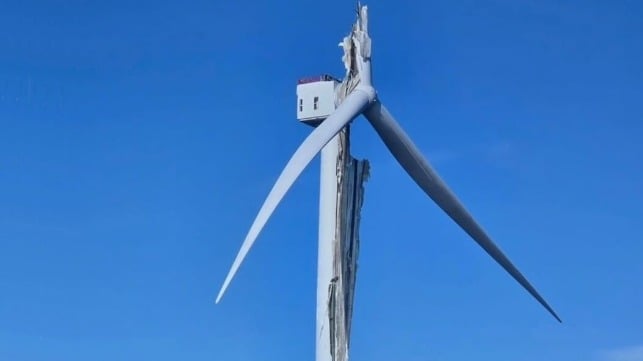Additional Blades Require Reinforcing as Work Proceeds at Vineyard Wind

GE Vernova and Vineyard Wind, a joint venture project between Avangrid and Copenhagen Infrastructure Partners, detailed the next phase of their recovery effort after the offshore wind farm experienced a blade failure more than three months ago. Problems at the project continue to place financial pressures on GE Vernova which last month reported in the face of continuing financial losses it would be scaling back its efforts tied to offshore wind power generation.
Installation offshore was well underway at Vineyard Wind south of Martha Vineyard in Massachusetts when one of the approximately 330-foot-long blades on one of the 24 installed turbines fractured. Pieces of the blade fell into the water with some parts sinking while other shards began washing up on Massachusetts’ beaches causing an outcry from residents and critics of offshore wind. The damaged blade further broke in the following days.
GE Vernova is now reporting after an extensive review of more than 8,300 ultrasound images per blade and physical blade inspections with “crawler” drones, it has found additional issues in the manufacture of an unspecified number of the blades and if they have been installed. Company CEO Scott Strazik told Bloomberg that defects similar to the failed blade were found on “a low-single digit percentage of its blades.”
The company previously blamed the failure on problems in the bonding process at its manufacturing plant in Canada. Speaking to investors today, Strazik repeated that it was a “manufacturing deviation,” that he previously said should have been detected by quality control.
“Out of an abundance of caution, GE Vernova intends to remove some blades from the Vineyard Wind farm while strengthening other blades as needed to support the safety and operational readiness of this project,” the company said in its announcement. The work will be done either at the plant or in the field but no timeline was specified for how long it would take.
After the incident, regulators suspended work on the project but later permitted some work to proceed. Following authorization in mid-August to resume certain activities, eight new towers and nacelles were installed the companies reported. They were also granted approval on October 22, to return to installing new blades on turbines at the project once stringent safety and operational conditions are met. Power generation however remains suspended.
They also reported that the recovery effort tasks including blade rotations to reduce blade debris, the removal of the hanging portion of the blade, and the clearing of debris from the platform have been completed. Resolve Marine was retained and the removal of seabed debris began on October 13 and will be completed this week. The final task, the removal of the root of the blade from the rotor hub, is expected to occur in the coming weeks.
GE Vernova and Vineyard Wind reported they are focused on these critical pathways, the final step in the action plan, and operations and power production will resume only after additional progress is made and all requisite approvals are granted. The approved construction plan calls for a total of 62 turbines generating 800 MW of power.
The update came as GE Vernova reported third quarter financial results. While the company reduced its financial loss from operations, the loss was higher than projected by analysts. Company executives cited the continuing issues in the wind power business saying that it was being offset by stronger results in its energy and electrification sectors. The company however reaffirms its financial guidance for 2024.
The partners in Vineyard Wind have been undeterred by the problems and delays for the first project. It had become the largest operating offshore wind farm in the United States and they are confident the project will get back on track. They have also submitted proposals for additional projects as states continue to move forward with their solicitation process for offshore wind power generation.
